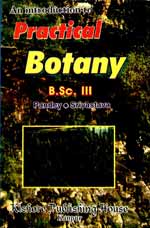|
वनस्पति विज्ञान >> एन इन्ट्रोडक्शन टु प्रैक्टिकल बॉटनी - 3 एन इन्ट्रोडक्शन टु प्रैक्टिकल बॉटनी - 3डॉ. एस एन पाण्डेयके सी श्रीवास्तव
|
|
||||||
एन इन्ट्रोडक्शन टु प्रैक्टिकल बॉटनी - 3
एन इन्ट्रोडक्शन टु प्रैक्टिकल बॉटनी - 3 इन इंगलिश मीडियम
CONTENTS
1. Introduction 3-10
Laboratory methods, Fixation, Staining. Permanent slides, Mounting, The Compound Microscope.
2. Ecological Anatomy 11-42
Hydrophytes. Xerophytes, I. Cynodon, 2. Cupparis. 3. Cusuurina. 4. Ruscus (Stem), 5. Ruscus (Phylloclade). 6. Acacia (Phyllode). 7. Muehlenbeckiu (Phylloclade). 8. Ficus (Leaf), 9. Nerium (Leaf), 10. Tiphu (Leaf), 11. Hitrilla (Stem), 12. Jussiuca (Stem), 13. Eichhornia (Petiole), 14. Eichhorniu (Root), 15. Nymphaeu (Petiole). 16. Numphaea (Leaf), 17. Potamogeton (Leaf).
3. Study of Soil and Plant Communities 43-61
Study of Soil: 1. To study soil profile of an area, 2. To determine bulk density of the soil, 3. To determine specific gravity of soil, 4. To study colour, texture, temperature and pH of soil, 5.To determine moisture content of the soil, 6.To determine water holding capacity of the soil, 7. To estimate qualitatively the carbonate and nitrate contents in different soil types, 8. Estimation of total Nitrogen in a given sample of soil.
Study of Plant Communities : 9.To compare the biomass production of conserved (undisturbed) and grazed sites of grassland, 10. To determine minimum size of quadrat by Species Area Curve inethod, 11. To determine the Frequency, Density and Abundance of plant species in a community in a given area, 12. To determine Frequency, Density and Abundance of plant species by Line Transect method, 13. To determine basal cover of an area, 14.To determine Relative Dominance, Relative Density and Relative Frequency and importance Value Index of plant species in a given area.
4. Environmental Pollution 62-86
Environment and pollution.
Air Pollution Studies : 1. To measure dust fall in a area. 2. To determine the average particle size and total particle load per unit area.
Water Pollution Studies : 3. To determine pH of given sample of water and comment upon its nature, 4. To determine total solids, suspended matter and total dissolved solids in given water sample, 5. To determine total alkalinity of water sample, 6. To determine total hardness of given water sample, 7. To determine carbonate and noncarbonate hardness of water sample, 8. To determine carbonate and bicarbonates in the given sample of water, 9. To determine dissolved oxygen in water sample, 10. To detect principal water and soil pollutants, 11. To identify algae present in a water reservoir and to determine status of organic pollution, 12. To determine algal pollution index of a given water reservoir, Algae found in polluted water- Cyanophyceae, Chlorophyceae and Bacillariophyceae, Microscopic Examination of a sample of Polluted Water,
Object. 1. To identify four algae of a sample of Moderateh polluted water,
Object 2. To identify four algae of a sample of Pollued water,
Object 3. To identify four algae of a sample of Hernily polluted water.
5. Plant Pathology 87-122
Diseases caused by Virus, Diseases caused by Bacteria, Diseases caused by Fungi Damping off Seedlings, Late Blight of Potato, White Rust, Black or Stem Rust of Wheat, Yellow or Stripe Rust of Wheat, Brown or Orange Rust of Wheat, Rust of Linseed, Red Rof of Sugarcane.
6. Specimens 123-156
i. Ecological Morphology - 1. Hydrilla, 2. Nymphaea (Leaf), 3. Water Hyacinth plant, 4. Plant of Opuntia, 5. Twig of Asparagus, 6. Ruscus (Phylloclade), 7. Phyllode (Petiole) of Acacia, 8. Casuarina, 9. Calotropis, 10. Cocoloba (Muehlenbeckia), 11. Nerium (Oleander) Twig, 12. Capparis (Twig), 13. Polygonum (Twig).
ii. Plant Resource Utilization - 1. Wheat (Triticum aestivum or T. vulgare), 2. Rice (Onza sativa), 3. Red gram (Cajanus cajan). 4. Gram or Chick pea (Cicer arietinum), 5. Pea or Matar (Pisum sativum), 6. Green gram or Moong (Phaseolus aureus syn. Vigna radiata), 7. Black grain or Urd (Phaseolus mungo syn. Vigna radiata), 8. Soybean (Glycine mar), 9. Cane sugar (Saccharum officinarum), 10. Potato or Irish Potato (Solanum tuberosum), 11. Mustard (Seeds or Oil) (Brassica campestris), 12. Groundnut or Groundnut Oil (Arachis hypogea), 13. Coriander (Coriander sativuun), 14. Turmeric curcuma (Curcuma domestica), 15. Tea (Camellia sinensis), 16. Cotton (Gossypium sp.), 17. Jute (Corchorus capsularis), 18. Tulsi (Ocimum sanctum), 19. Sarpgandha (Rawolfia serpentina), 20. Neem or Margosa (Azadirachta indica), 21. Safed Arand (Jatropha curcas), 22. Teak or Sagwan (Tectona grandis).
iii. Plant Pathology Specimens - 1. Leaf cui disease of papaya, 2. Tobacco Mosaic Disease, 3. Leafcuri disease of potato, 4. Yellow vein mosaic of Abelmoschus (Bhindi), 5. Citrus canker disease on citrus plant twig, 6. Citrus canker disease on citrus leaf, 7. Citrus canker disease on citrus fruit, 8. Damping off Seedlings, 9. Infected Colocasia leaf with Phytophthora, 10. A potato plant twig infected with Phytophthora, 11. Leaf of mustard infected with white rust (Custopus or Albugo), 12. Inflorescence of mustard infected with Cystopus, 13. Wheat leaf showing black rust disease. 14. Wheat leaf showing brown rust disease, 15. Wheat leaf showing yellow rust disease, 16. Rust infected Berberis leaf. 17. Linseed rust. 18. Infected sugarcane showing Red rot disease.
7. Problems on Biostatistics 157-172
Mean, Median, Mode, Standard Deviation. Stanuard Error, Variance, Coefficient of Variation. Correlation, Test of Significance, Chi-Square Test, Graphic Representation of Data.
8. Viva-voce 173-199
|
|||||














